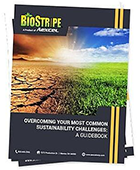Sustainability: How Does Your Organization Define It?
Defining sustainability can be a moving target to say the least. Organizations must examine their own unique circumstances and challenges in formulating their long term sustainability strategies. Formulating strategy must begin with a well-defined goal and vision for organizational sustainability. This definition lays the groundwork for overall action.
Defining Sustainability
In 1987, the Brundtland Commission set defined sustainability for the United Nations in an effort to address the global environmental challenges arising from 20th Century industrialization. Paraphrasing, the definition depicted the challenge of meeting today’s needs without jeopardizing those of future generations. Additionally, they said, sustainable goals must address economic, social, and environmental impacts. This macro definition still stands as the basis for sustainable efforts around the world.
“Triple Bottom Line”
In 1994, economist John Elkington’s definition brought further clarity to the role of sustainability in a business context. He introduced the concept of “Triple Bottom Line” (TBL) by reducing the 3 pillars of the UN’s definition of economic development, social responsibility, and environmental excellence into the word grouping “profit, people, and planet.” Companies employ this approach to measure beyond the traditional elements of profit and return on investment to consider social and environmental impact of decisions and policies.

As organizations adopt the concept of TBL accounting, many struggle with quantifying the social and environmental impacts. Measuring the “profit” element of TBL is fairly straight forward because of standard accounting practices. Measuring contributions to the ecology and community requires more subjective measures. To address this, many organizations have developed specific measurements in either currency terms or with defined indexes. A measurement of environmental improvement may be in tons of waste or reduced fuel usage, for example. Social or community progress might be measured in contributions of time and money.
How Do the 3 Ps Work?
With the 3 Ps, “Profit, People, and Planet,” as a basis, any organization can develop their definitions and mission statement while being mindful of their impact in each area. This approach to sustainability suggests that no element, say profit, should ever be embraced at the expense of the others. Under this approach, it is unwise to chase profits at the expense of the environment and community. Likewise, only focusing on environment impact without achieving considering profit could cause the organization (and the leaders) to disappear quickly. Fortunately, these are not mutually exclusive concepts.
Approaching the profit, people, and planet with a balanced mission is essential. Investments in more efficient energy, water usage, and waste management save money. Positive community involvement and improved employee engagement can result in more sales, lower turnover, and higher profit.
Go for the Gold (In More Ways Than One)
Setting high standards for profitability, environmental consciousness, and community involvement should be the ultimate objective.
- Craft the organization’s definition of sustainability.
- Balance Profit, Planet, and People in the Mission Statement.
- Create supporting objectives to achieve maximum returns in each area.
- Create metrics that quantify activities in each area and develop action plans that contribute to improving one or more of these three elements.
- Execute your sustainability plan.
Now it’s time to ask yourself, how does your organization define sustainability? Share your thoughts in the comments!


